Guillaume Delisle
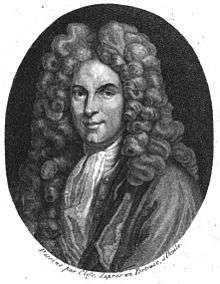
Guillaume Delisle, also spelled Guillaume de l'Isle, (28 February 1675, Paris – 25 January 1726, Paris[1]) was a French cartographer known for his popular and accurate maps of Europe and the newly explored Americas and Europe.
Childhood and education
Deslile was the son of Marie Malaine and Claude Delisle (1644–1720), who later remarried Charlotte Millet de la Croyère after his first wife died following childbirth. It is possible that the couple had as many as 12 children, but many of them died at a young age. Although Claude Delisle had studied law, he also taught history and geography. Claude had such a good reputation in Paris’ intellectual circles that he educated lords, among them was the duke Philippe d’Orléans who later became regent for the crown of France, and collaborated with well-known cartographer Nicolas Sanson. Guillaume and his two of half-brothers, Joseph Nicolas and Louis, ended up pursuing similar careers in science.[2]
While Claude certainly has to be given credit for Guillaume’s education, the latter showed early signs of being an exceptional talent. He would soon contribute to the family workshop by drawing maps for his father’s historical works. Some have questioned the authorship of these first maps, saying that Delisle only copied what Claude had done before him, but his work is not that surprising since he had gained experience during his childhood. In order to perfect his skills, Guillaume Delisle became the student of the astronomer Jean-Dominique Cassini. Early on he produced high quality maps, the first being his Carte de la Nouvelle-France et des Pays Voisins in 1696.[3]:21, 25
Career
_-_Geographicus_-_AmeriqueSeptentrionale-covensmortier-1708.jpg)
At 27, Delisle was admitted into the French Académie Royale des Sciences, an institution financed by the French state. After that date, he signed his maps with the title of “Géographe de l’Académie”. Five years later, he moved to the Quai de l’Horloge in Paris, a true publishing hub where his business prospered. Delisle’s ascension through the ranks culminated in 1718 when he received the title of Premier Géographe du Roi.[3]:43–47 His new office consisted in teaching geography to the Dauphin, King Louis XIV’s son, a task for which he received a salary. Again, Claude Delisle’s reputation as a man of science probably helped Guillaume. This supports the claim of the historian Mary Sponberg Pedley, who says “once authority was established, a geographer’s name might retain enough value to support two or three generations of mapmakers”.[4] In Delisle’s case, it could be said that his accomplishments surpassed his father’s. Up to that point, he had drawn maps not only of European countries, such as Italy, Spain, Germany, Great Britain, Poland, and regions such as the Duchy of Burgundy, but he had also contributed to the empire’s claims to recently explored continents of Africa and the Americas.[5]:62
Like many cartographers of his day, Delisle did not travel with the explorers and elaborated the maps mostly in his office. The quality of his maps depended on a solid network that would provide him first-hand information. Given the family’s reputation and his own, Delisle had access to fairly recent accounts of travellers who were coming back from the New World, which gave him an advantage over his competitors. Being a member of the Académie, he was also aware of recent discoveries, especially in astronomy and measurement. When he could not confirm the accuracy of his source, he would indicate it clearly on his maps. For instance, his Carte de la Louisiane shows a river that the baron of Lahontan claimed he discovered, but no one else could validate it, so Delisle warned the viewer that its actual existence was in doubt.[3]:41 Delisle's search for exactitude and intellectual honesty entangled him in a legal dispute in 1700 with Jean-Baptiste Nolin, a fellow cartographer.[5]:155 Noticing Nolin had used details that were considered original from his Map of the World, Delisle dragged Nolin in court to prove his plagiarism. In the end, Delisle managed to convince the jury of scientists that Nolin only knew the old methods of cartography and therefore that he had stolen the information from his manuscript. Nolin's maps were confiscated and he was forced to pay the court costs.[4]:39 The scientificity of the work produced by the Delisle family contrasted with the workshop of Sanson. While Sanson knowingly published outdated facts and mistakes, Delisle strived to present up-to-date knowledge.[3]:41
Legacy
After Guillaume Delisle's death in 1726, his widow tried to preserve the workshop and protect the family. She appealed to the king with the help of the abbot Bignon, the king’s librarian and president of the academies. By that time, Guillaume's brothers Joseph-Nicolas and Louis had already left to serve Peter the Great in Russia. The youngest Delisle, Simon Claude, lacked practical knowledge in cartography and he asked for the king's help in finding him an associate. The Delisle workshop was then bequeathed to Philippe Buache.[3]:41
Dutch cartographer Jan Barend Elwe reissued maps by Delisle in the late 18th century.[6]
Context: Cartography in France
Historian David Buisseret has traced the roots of the flourishing of cartography in the 16th and 17th centuries in Europe and noted it was due to five distinct reasons: admiration of antiquity, especially the rediscovery of Ptolemy, considered to be the first geographer; increasing reliance on measurement and quantification as a result of the Scientific revolution; refinements in the visual arts such as the discovery of perspective, that allowed for better representation of spatial entities; development of estate property; and the importance of mapping to nation-building.[7]
The reign of Louis XIV is generally considered to represent the beginning of cartography as a science in France.[8]:42 The evolution of cartography during the transition between the 17th and 18th centuries involved advancements on a technical level, as well as those on a representative level. According to Marco Petrella, the map developed ‘from a tool used to affirm the administrative borders of the reign and its features…into a tool which was necessary to intervene in territory and thus establish control of it.’[9] Because unification of the kingdom necessitated well-kept records of land and tax bases, Louis XIV and members of the royal court pushed the development and progression of the sciences, especially cartography. Recognizing this imperative, Louis XIV established The Académie des Sciences in 1666 with the expressed purpose of improving cartography and sailing charts as it was found that all the gaps of knowledge in geography and navigation could be accounted for in the further exploration and study of astronomy and geodesy.[10] Colbert also attracted many foreign scientists to the Académie des Sciences to support the pursuit of scientific knowledge.[8]:45
Under the auspices of the Sun King and Jean-Baptiste Colbert, members of the Académie des Sciences made many breakthrough discoveries within the realm of cartography in order to ensure accuracy of the works of cartographers. Among the more prominent work done with the Académie was that done by Giovanni Domenico Cassini, who perfected a method of determining longitude by the observation of movement of Jupiter’s satellites.[11] Cassini, along with the aid and support of mathematician Jean Picard, developed a system of uniting the provincial topographical information into a comprehensive map of the country through a network of surveyed triangles. It established a practice that was eventually adopted by all nations in their project to map the areas under their domain.[10]:18 For their method of triangulation, Picard and Cassini used the meridian arc of Paris-Amiens as their starting point.[9]:21
Jean-Baptiste Colbert, the secretary of home affairs and prominent member of Louis XIV’s royal court, set out to develop the resource base of the nation and to develop a system of infrastructure that could restore the French economy and to supply income for the profuse expenses incurred by Louis XIV. What Colbert lacked in his pursuit of the development of the economy was a map of the entire country. France, like all other countries of Europe, operating on local knowledge; within France, all systems of measuring weight and taxes were local and thus a uniform notion of land surveying was not present.[10]:16 The advancements made by the members of the Académie des Sciences proved instrumental as a tool to aid reform within the nation; cartography was an important element in two major reforms undertaken by Colbert: the reform of royal forest, a project undertaken beginning in 1661 and naval reform, initiated in 1664.[8]:44
In 1663–1664 Colbert made an inquiry into the provinces in an effort to accurately assess the income within the kingdom, necessary information for economic and tax reform. Colbert asked for the provincial representatives of the king, the intendants, to gather existing maps of territory within the provinces and check them for accuracy. If they were found not to be accurate, the Royal Geographer, Nicolas Sanson, was to edit them, basing his source of information on the reports that the intendants prepared. The operation was largely failure due to the scrutinizing examination of cartographic methodology with the Académie des Sciences.[8]:45 The importance of cartography to the mechanisms of the state, however, continued to grow.
Paris as the center of cartography
The seventeenth century marked the emergence of France as the center of the map trade in Europe, with much of the production and distribution of maps taking place in the French capital of Paris.[12]:33–45 In conjunction with the support of the development of the sciences, the royal court encouraged the prosperity of arts and artisans within and the support given by the royal court attracted artists to Paris. As a result, many mapmakers, such as Nicolas Sanson and Alexis-Hubert Jaillot, moved to the national capital from the peripheries of the provinces.[12]:34
Moreover, many of the agents of cartography, including those involved in the creation, production and distribution of maps in Paris lived in the same section of the capital city. Booksellers congregated along rue St-Jacques along the left bank of the Seine, while engravers and cartographers lived along the Quai de l’Horloge on the Île de la Cité (See Figure 1). Regulations enacted by the communautés informed the location of the libraries. These regulations included that each bookseller-printer was to have one shop, which had to be located in the University quarter or on the quai de l’Horloge. These restrictions provided by easier inspection by the authorities to enforce other regulations such as: printer need to register the number of presses they owned and any books that were printed had to be registered and approved by the royal court before it could be sold.[12]:34 Opticians were also located with the Quai de l’Horloge and their tools – squares, rules, compasses and dividers – were essential to the practice of cartography.[12]:37 Many of the cartographers that worked within the confines of Paris never actually set foot outside of the city in order to gather to essential survey knowledge to produce their maps. These were known as the geographes de cabinet. An example of such a cartographer was Jean-Baptiste Bourgignon d’Anville, who compiled his information from ancient and modern sources, verbal and pictorial, published and even unpublished sources.[12]:39
Delisle's maps
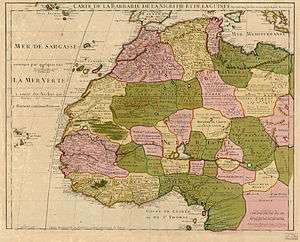
Louisiana
Delisle’s 1718 Carte de la Louisiane et du Cours du Mississippi is an example of French cartography at its height, produced at a time when the rest of Europe looked to France for the most accurate maps. It had a wide circulation in Europe and remained in print for years, either copied exactly or used as a base map.[13]:19 It became a source map for all succeeding maps of the Mississippi River as a result of its accurate representation of the lower Mississippi and the surrounding areas.[14] It is particularly notable for its relatively accurate depiction of the Gulf area, as well as the wealth of detail and information provided therein.[15] The map is centered on the interior of what would later become the continental United States and the Mississippi, and it spans the area from the bottom of Lake Superior in the north to the point at which the Rio Grande meets the Gulf of Mexico in the south; the map also extends eastward from the Rocky Mountains to the Atlantic coast.[13]:21
The map is very detailed, including information on both Indian spaces and English colonies.[16] There are hundreds of labels on the map providing the names of lakes, rivers, colonies, cities, forts, mountains, and the names of Indian tribes. It is ornamented with animals, ships, and cities marked by small squares, circles, or rectangles with crosses on the top. These symbols are marked in the legend, which is located at the bottom of the map and which also makes note of Indian habitations and includes an undulating line used to mark the routes of Fernando de Soto and Louis de Moscoso in the area of the Mississippi where they were chased by Indian tribes. Next to the legend is a 16-point compass placed in the center of the Gulf of Mexico with a fleur-de-lis indicating the geographic north; the magnetic north is omitted from the compass, suggesting that the map was not created as for navigational purposes.[13]:25–26
For the Carolina region, extending into present-day Tennessee and Kentucky, the map lacks detail and accuracy; for example, there is a flawed conception of the Appalachians as reaching into the Michigan peninsula, an error potentially borrowed from earlier maps by Morden Brown or Sanson.[15] The largest area of the map by far was “La Louisiane”, or Louisiana, proposing a pro-French version of the continent and conveying the message that it had become an enormous and firmly established colony by 1718; in reality, this colony was really made up of between four hundred to seven hundred men, women, and children clustered around the mouth of the Mississippi.[13]:41 As a message to the French king, the map clearly labeled major waterways and copper mines which would serve to boost the nation’s commerce.[13]:41 In this way it was considered to be a politically charged document also depicting explorer’s routes and controversial territorial claims in the New World.
The British and Spanish areas of the map appear small compared to those of the French, even though the French presence in the interior of the continent was actually minimal.[13]:19–20 The map extended the territories under French control by pushing the British colonial border further east than the Appalachian frontier, and then further incensed the British by claiming that Carolina was named for the French king, Charles IX, and not for England’s Charles II. The perceived territorial offenses against the British colonies on the map caused a political controversy in England and France which lasted for at least fifteen years.[5]:66 The English Board of Trade filed several complaints, and in 1720 a rival map was made by Englishman Herman Moll. This map, therefore, also illuminates the complex relationship between Europe and the Americas known as the Trans-Atlantic Exchange.[13]:19–20 Delisle also extended the French territorial claims to the Rio Grande and Pecos River, much to the outrage of Spain, causing Spanish cartographers to produce some of their own maps which had previously remained “virtual state secrets.” Nevertheless, just months after the appearance of Delisle’s map of Louisiana, Louis XV awarded him the unique title of premier geographe du roi, with a pension of 1200 livres.[5]:66–67
The Delisle map of 1718 also importantly represents a major shift in cartographic authority in the Western cartographic tradition from the classical Greek traditions to one based more heavily on science. Delisle based this and other maps on astrologically determined latitudes and longitudes as well as on critical examinations of primary and secondary source material. In this way, this map is a precursor to the more scientific and imperial minded cartography of the later part of the eighteenth century.[13]:10–13
New France
Delisle’s 1703 Carte du Canada ou de la Nouvelle France is praised as the first map to correctly depict the latitude and longitude of Canada. To accomplish this feat, Delisle – while never having personally visited the New World – devoted seven years to in-depth research. He made several earlier sketches drawn from information extracted from the Jesuit Relations, and personal relationships with many missionaries and explorers enhanced his ability to gain a rather extensive knowledge of the landscape. He also used calculations of the eclipse to find the precise longitude of Quebec which had, up until that point, only been guessed at. The research behind this map, in addition to its mathematical nature, made it a standard for maps to come. It had a large impact when it was published, underscoring the French strength in New France in the early 18th century, and it stood out as an early example of a more dispassionate, scientific type of map relative to the impressionistic ones of centuries before.[17]
The map itself is quite detailed, covering such vast areas as New France, Greenland, Labrador, Hudson Bay, Baffin Bay, and the Great Lakes and Arctic regions.[18] Delisle did not attempt to fill in areas of white space where his knowledge was insufficient, rather he let these spaces remain, a decision indicative of cartographical renewal in France in that period.[19] In despite of these holes and the scientific nature of his map, Delisle’s 1703 Carte still contains a large amount of information from Indians and considerations on imperial influence. In at least one instance, Delisle employed information from Indians that was not necessarily confirmed by a European authority. For example, on the map, Lake Winnipeg – marked as Lac des Assenipoils – is shown with its water communication down to the Hudson Bay, information taken from an Indian report rather than one of European discovery. Furthermore, although hundreds of Indian tribes were identified in Delisle’s earlier sketches, he consolidated a number of related bands under one heading in his final map. In other instances, information about certain traditional grounds provided in earlier maps, such as those of the Mistassini Cree, was omitted in Delisle’s 1703 map either due to famine, disease, or collapse of hunting grounds.
The map provides a large cartouche in the upper left corner, which includes scenes from the New World implying imperial claims. The cartouche was done by the artist N. Guerard and carried the symbol of French royalty. Other parts of the cartouche included a Jesuit missionary performing a baptism of an Indian and a Recollects missionary guiding Indians toward the road to heaven. There is also the image of an Iroquois brandishing a scalp of a Frenchman, and Iroquois on a bed of thistles, a Huron holding rosary beads, and beaver. In this way, the map – which is otherwise relatively scientific – is not entirely depoliticized.[17]
Map gallery
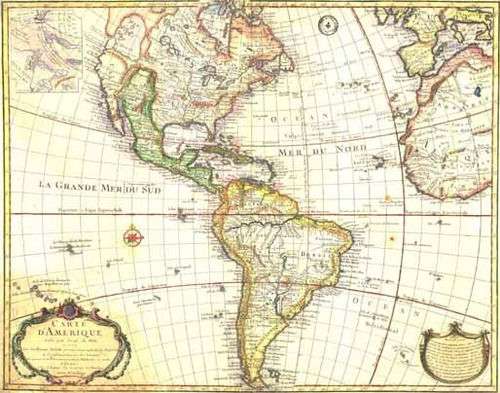
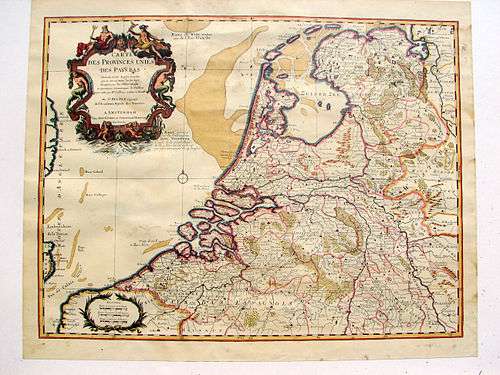
Gallery of maps extracted from Delisle's Carte de la Louisiane et du cours du Mississippi, 1718
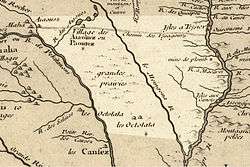


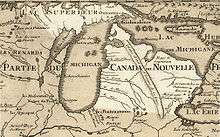
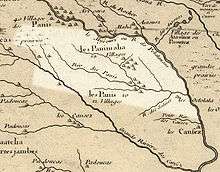
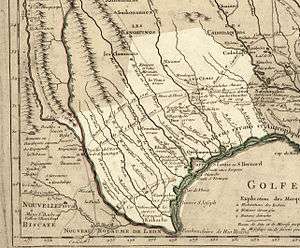

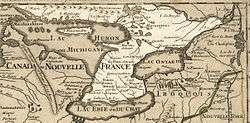
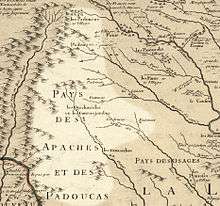 Comanche range
Comanche range
Honours
Delisle Inlet in Antarctica is named after Guillaume Delisle.
References
- ↑ http://www.britannica.com/EBchecked/topic/156617/Guillaume-Delisle
- ↑ RV Tooley, “Guillaume Delisle”, In Tooley’s Dictionary of Mapmakers. New York: Meridian Publications, 1979, 353.
- 1 2 3 4 5 Nelson-Martin Dawson, L’Atelier Delisle : L’Amérique du Nord sur la table à dessin, Sillery: Éditions Septentrion, 2000.
- 1 2 Mary Sponberg Pedley, The Commerce of Cartography: Making and Marketing Maps in Eighteenth-Century France and England, Chicago: University of Chicago Press, 2005.
- 1 2 3 4 Christine Marie Petto, When France was King of Cartography: The Patronage and Production of Maps in Early Modern France, Lanham: Lexington Books, 2007.
- ↑ "Map of Barbary, Nigritia and Guinea". World Digital Library. Retrieved 29 April 2013.
- ↑ Conley, Tom. The Self-Made Map: Cartographic Writing in Early Modern France. Minneapolis: University of Minnesota Press, 1996.
- 1 2 3 4 Pelletier, Monique. “Cartography and Power in France During the Seventeenth and Eighteenth Centuries,” Cartographica 35 (1998).
- 1 2 Petrella, Marco. “Guillaume Delisle’s Carte du Duche de Bourgogne: The Role of Central and Peripheral Authorities in the Construction of a Provincial Territory in France in the Early 18th Century,” Journal of Map & Geography Libraries 5 (2008): 17-39.
- 1 2 3 Turnbull, David. “Cartography and Science in Early Modern Europe: Mapping the Construction of Knowledge Spaces,” Imago Mundi 48 (1996): 5-24.
- ↑ Crone, G.R. Maps and their Makers. London: Hutchinson & Co, 1953.
- 1 2 3 4 5 Pedley, Mary Sponberg. “The Map Trade in Paris, 1650–1825,” Imago Mundi 33 (1981).
- 1 2 3 4 5 6 7 8 Andrew Balash, How Maps Tell the Truth by Lying: An Analysis of Delisle’s 1718 Carte de la Louisiane. (Master’s diss., University of Texas at Arlington, 2008).
- ↑ Christine M. Petto, "From L’état, c’est moi to c’est l’état: Mapping in Early Modern France," Cartographica, 40 (2005): 6.
- 1 2 William Patterson Cumming, The Southeast in Early Maps, 3rd ed, (Chapel Hill: University of North Carolina Press, 1998), 178.
- ↑ Lorraine, Dubreuil, Early Canadian Maps: the WH Pugsley Collection, Carte de la Louisiane et du Cours du Mississippi (Montreal: Rare Books and Special Collections Divisions, McGill University Libraries, 1998).
- 1 2 Alan Morantz, Where is Here? Canada's Maps and the Stories They Tell, (Toronto: Penguin Books, 2002), 42-5.
- ↑ Dubreuil, Early Canadian Maps: the WH Pugsley Collection, La Carte du Canada ou de la Nouvelle France
- ↑ Christian Jacob, The Sovereign Map: Theoretical Approaches in Cartography throughout History, (Chicago: The University of Chicago Press, 2006), 146.
Further reading
- D'Alembert, Denis Diderot and Jean-Pierre Mouchon. Encyclopédie ou Dictionnaire raisonné des sciences, des arts et des métiers: Tome vingt-unième. Paris: Briasson, 1751.
- L'Italien, Raymonde. Mapping a Continent: Historical Atlas of North America, 1492–1814. Sillery: Éditions Septentrion, 2007.
| Wikimedia Commons has media related to Guillaume Delisle. |